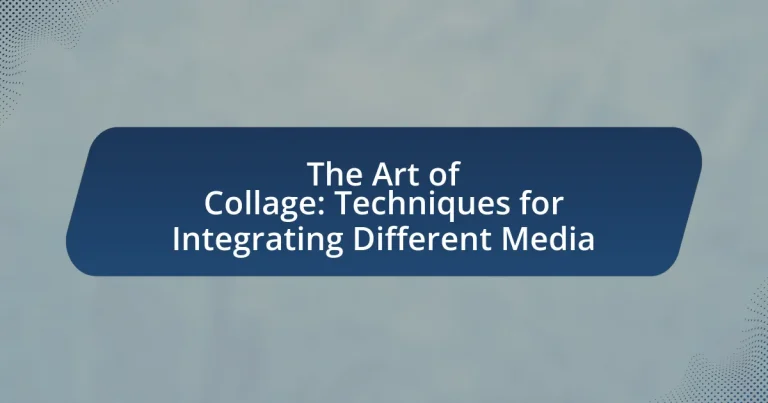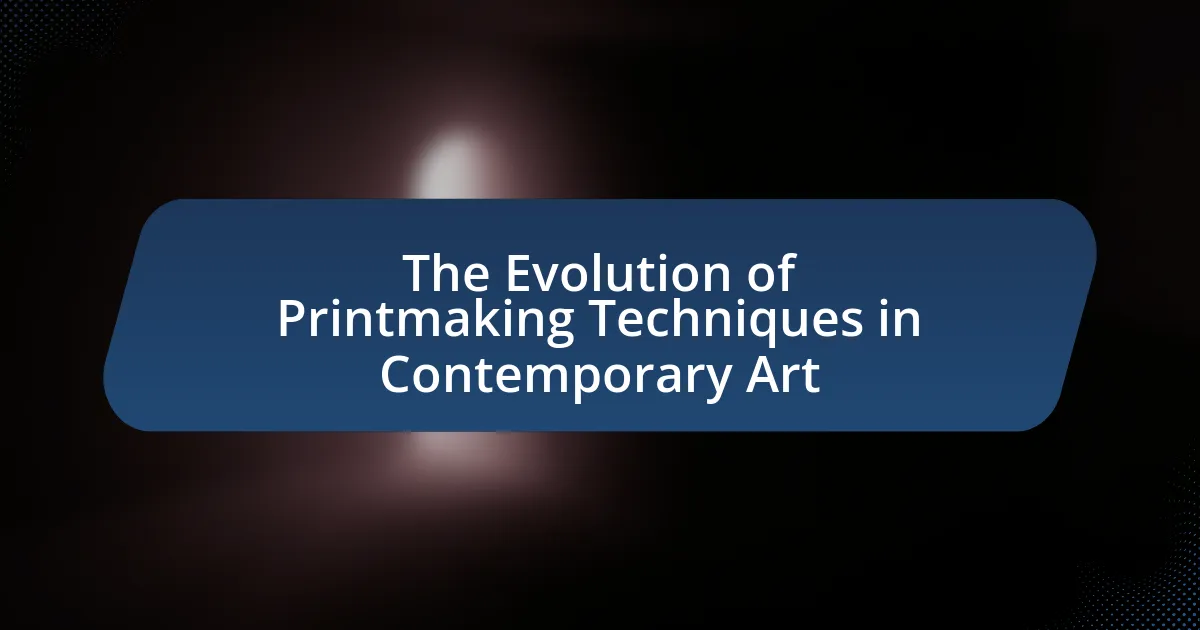The art of collage is a creative technique that involves assembling various materials, such as paper, photographs, and fabric, to create unified artworks. Originating in the early 20th century, collage was pioneered by artists like Pablo Picasso and Georges Braque, who broke traditional artistic boundaries. This article explores the historical movements that influenced collage, key figures in its development, fundamental principles, and popular techniques used in its creation. Additionally, it addresses challenges artists face in collage making and offers strategies for successful integration of diverse media, emphasizing the importance of composition, color, and texture in enhancing visual impact.

What is the Art of Collage?
The art of collage is a creative technique that involves assembling various materials, such as paper, photographs, fabric, and other objects, to create a unified artwork. This method allows artists to explore different textures, colors, and forms, resulting in a multi-dimensional piece that often conveys complex themes or narratives. Historically, collage emerged in the early 20th century, with artists like Pablo Picasso and Georges Braque pioneering its use in modern art, demonstrating its potential to challenge traditional artistic boundaries and engage viewers in new ways.
How did the art of collage originate?
The art of collage originated in the early 20th century, primarily associated with the Cubist movement led by artists like Pablo Picasso and Georges Braque. These artists began incorporating various materials such as paper, fabric, and found objects into their works, breaking traditional boundaries of painting. The term “collage” itself derives from the French word “coller,” meaning “to glue,” which reflects the technique’s fundamental process of adhering different elements together. This innovative approach allowed for new forms of expression and the exploration of mixed media, influencing subsequent art movements such as Dada and Surrealism.
What historical movements influenced the development of collage?
The development of collage was influenced by several historical movements, notably Cubism, Dadaism, and Surrealism. Cubism, pioneered by artists like Pablo Picasso and Georges Braque in the early 20th century, introduced the idea of fragmented forms and multiple perspectives, which laid the groundwork for collage techniques. Dadaism, emerging during World War I, embraced randomness and absurdity, encouraging artists to incorporate found objects and materials into their work, exemplified by artists like Marcel Duchamp. Surrealism further expanded collage’s boundaries by blending dreamlike imagery with reality, as seen in the works of Max Ernst and André Breton. These movements collectively shaped the evolution of collage as a distinct art form, emphasizing innovation and the integration of diverse media.
Who are some key figures in the history of collage?
Key figures in the history of collage include Pablo Picasso, Georges Braque, and Hannah Höch. Pablo Picasso and Georges Braque pioneered the technique in the early 20th century, particularly in their development of Cubism, where they incorporated materials like newspaper and wallpaper into their artworks. Hannah Höch is recognized for her innovative use of photomontage, contributing significantly to the Dada movement and exploring themes of gender and identity through her collages. These artists played crucial roles in establishing collage as a legitimate art form, influencing countless others in the realm of mixed media.
What are the fundamental principles of collage?
The fundamental principles of collage include the use of juxtaposition, layering, and the integration of diverse materials to create a cohesive artwork. Juxtaposition involves placing contrasting elements side by side to create visual interest and provoke thought. Layering allows for depth and complexity, as different materials and images overlap to form new meanings. The integration of diverse materials, such as paper, fabric, and found objects, enhances texture and richness in the composition. These principles are essential for achieving the dynamic and multifaceted nature of collage art.
How do composition and layout affect a collage?
Composition and layout significantly influence the effectiveness and visual appeal of a collage. A well-structured composition guides the viewer’s eye, creating a focal point and establishing a narrative, while an organized layout ensures that elements are harmoniously arranged, enhancing the overall aesthetic. For instance, the rule of thirds can be applied to position key elements strategically, leading to a more engaging visual experience. Research in visual perception indicates that balanced compositions are more likely to attract and retain viewer attention, supporting the idea that thoughtful arrangement enhances the impact of the collage.
What role does color play in collage creation?
Color plays a crucial role in collage creation by influencing the emotional response and visual harmony of the artwork. The selection of colors can evoke specific feelings, create focal points, and establish a cohesive theme throughout the collage. For instance, warm colors like red and yellow can generate energy and excitement, while cool colors such as blue and green can convey calmness and serenity. Research in color theory supports this, indicating that color combinations can significantly affect viewer perception and interpretation, as demonstrated in studies by artists and psychologists alike.

What techniques are used in collage creation?
Collage creation employs various techniques, including layering, juxtaposition, and mixed media integration. Layering involves placing multiple images or materials on top of one another to create depth and complexity. Juxtaposition refers to the placement of contrasting elements side by side to highlight differences or create new meanings. Mixed media integration combines different artistic materials, such as paper, fabric, and found objects, to enhance texture and visual interest. These techniques are foundational in collage art, allowing artists to explore creativity and express ideas through the combination of diverse elements.
How can different media be integrated in collage?
Different media can be integrated in collage by layering various materials such as paper, fabric, photographs, and found objects to create a cohesive visual composition. This technique allows artists to combine textures, colors, and forms, enhancing the overall aesthetic and narrative of the artwork. For instance, using mixed media techniques, artists can adhere photographs onto painted backgrounds, incorporate fabric swatches for texture, or add three-dimensional elements like buttons or beads, which can create depth and interest. The integration of these diverse materials is supported by the principles of design, such as balance and contrast, ensuring that the final piece is harmonious and engaging.
What types of materials are commonly used in collage?
Commonly used materials in collage include paper, fabric, photographs, and found objects. Paper serves as the primary medium, often sourced from magazines, newspapers, or handmade sheets, providing diverse textures and colors. Fabric adds depth and tactile quality, while photographs can introduce personal or historical elements. Found objects, such as buttons, leaves, or other small items, enhance the visual narrative and create a three-dimensional aspect. These materials collectively allow artists to explore creativity and express complex ideas through layered compositions.
How does layering enhance the visual impact of a collage?
Layering enhances the visual impact of a collage by creating depth and dimension, which draws the viewer’s eye and adds complexity to the composition. This technique allows for the juxtaposition of various materials and images, enabling the artist to convey multiple narratives or themes simultaneously. For instance, layering can create a sense of foreground and background, making certain elements stand out while others recede, thus guiding the viewer’s focus. Additionally, the interplay of textures and colors in layered elements can evoke emotional responses and stimulate visual interest, making the collage more engaging.
What are some popular collage techniques?
Some popular collage techniques include cut-and-paste, digital collage, and mixed media. Cut-and-paste involves physically cutting images from magazines or paper and adhering them to a surface, a method that has historical roots in early 20th-century art movements like Dadaism. Digital collage utilizes software to combine images and graphics, allowing for greater manipulation and layering, which became prominent with the rise of digital art in the late 20th century. Mixed media combines various materials such as paint, fabric, and found objects, enhancing texture and depth, a technique widely used by artists like Robert Rauschenberg in the mid-20th century.
How does digital collage differ from traditional collage?
Digital collage differs from traditional collage primarily in its medium and tools used for creation. Digital collage utilizes software and digital images, allowing for greater flexibility, ease of editing, and the ability to incorporate various digital effects. In contrast, traditional collage involves physical materials such as paper, fabric, and other tangible items, requiring manual cutting and gluing. The digital format enables artists to manipulate layers, adjust colors, and experiment with compositions without the limitations of physical materials, which can be more time-consuming and less forgiving. This distinction highlights the evolution of collage techniques in the digital age, where accessibility to digital tools has expanded creative possibilities.
What is the significance of texture in collage work?
Texture in collage work is significant because it adds depth, dimension, and visual interest to the composition. By incorporating various materials such as paper, fabric, and found objects, artists can create tactile experiences that engage viewers on multiple sensory levels. This use of texture not only enhances the aesthetic appeal but also conveys meaning and emotion, as different textures can evoke specific feelings or associations. For example, rough textures may suggest ruggedness or chaos, while smooth textures can imply calmness or simplicity. The interplay of textures in a collage can also guide the viewer’s eye and influence the overall narrative of the artwork, making it a crucial element in the collage-making process.

What are the challenges and solutions in collage making?
Collage making presents challenges such as material selection, composition balance, and adhesive issues. Material selection can be difficult due to the variety of textures and weights that may not adhere well together. To address this, artists can experiment with different combinations and test adhesives on sample pieces to ensure compatibility. Composition balance is another challenge, as it requires a keen eye to create visual harmony among diverse elements. Artists can overcome this by using design principles like contrast, repetition, and alignment to guide their arrangement. Adhesive issues, including warping or uneven application, can be mitigated by using appropriate adhesives for specific materials, such as glue sticks for paper and gel mediums for heavier items. These solutions enhance the overall quality and effectiveness of the collage.
What common mistakes do artists make in collage?
Artists commonly make mistakes in collage by failing to consider composition, balance, and the harmony of materials. Many artists neglect the importance of a cohesive visual narrative, leading to disjointed pieces that lack focus. Additionally, overloading a collage with too many elements can create visual clutter, detracting from the intended message. A lack of experimentation with textures and layering can also result in flat and uninspired works. These mistakes often stem from a misunderstanding of how different media interact, which can hinder the overall effectiveness of the collage.
How can artists avoid overcomplicating their collages?
Artists can avoid overcomplicating their collages by focusing on a clear theme and limiting the number of elements used. By selecting a specific concept, artists can streamline their choices, ensuring that each piece contributes meaningfully to the overall composition. Research indicates that simplicity often enhances visual impact; for instance, studies in design psychology show that viewers prefer compositions that are not overcrowded, as they are easier to interpret and engage with. Therefore, maintaining a cohesive theme and minimizing elements can lead to more effective and aesthetically pleasing collages.
What strategies can be employed to maintain balance in a collage?
To maintain balance in a collage, artists can employ strategies such as color harmony, visual weight distribution, and focal point placement. Color harmony involves selecting a cohesive color palette that unifies the elements, ensuring that no single color overwhelms the composition. Visual weight distribution requires careful arrangement of elements so that heavier or more complex items are balanced by lighter or simpler ones, creating a sense of equilibrium. Focal point placement directs the viewer’s attention to a specific area, allowing for a balanced interaction between the focal point and surrounding elements. These strategies are supported by principles of design, which emphasize the importance of balance in visual art to create aesthetically pleasing compositions.
What tips can enhance the collage-making process?
To enhance the collage-making process, artists should focus on selecting a cohesive theme that guides their material choices. A well-defined theme helps in creating a unified visual narrative, making the collage more impactful. Additionally, experimenting with various textures and materials, such as paper, fabric, and found objects, can add depth and interest to the composition. Research indicates that incorporating diverse media can stimulate creativity and lead to more innovative outcomes in visual art (Kätsyri et al., 2015, “The Role of Material in Creative Processes,” Journal of Creative Behavior). Furthermore, planning the layout before gluing elements down allows for adjustments and a more balanced design. Using a strong adhesive ensures that all components remain intact over time, preserving the artwork’s integrity.
How can artists find inspiration for their collages?
Artists can find inspiration for their collages by exploring diverse sources such as nature, urban environments, and personal experiences. Engaging with various materials like magazines, photographs, and textiles can spark creativity, as the juxtaposition of different elements often leads to innovative ideas. Additionally, studying the works of established collage artists and participating in workshops can provide new perspectives and techniques, enhancing an artist’s ability to create unique compositions. Research indicates that exposure to a wide range of stimuli can significantly boost creative output, as demonstrated in studies on creativity and environmental influences.
What best practices should be followed for successful collage integration?
Successful collage integration requires a clear vision and cohesive theme that unifies diverse media elements. This involves selecting materials that complement each other in color, texture, and style, ensuring that each component contributes to the overall narrative or aesthetic. Additionally, maintaining balance and harmony within the composition is crucial; this can be achieved by varying the scale and placement of elements to guide the viewer’s eye throughout the piece.
Research indicates that effective visual storytelling in collage can enhance viewer engagement, as seen in studies on art perception, which highlight the importance of coherence in mixed media works. For instance, a study published in the Journal of Visual Culture emphasizes that artworks with a strong thematic focus are more likely to resonate with audiences, reinforcing the need for a well-defined concept in collage integration.





